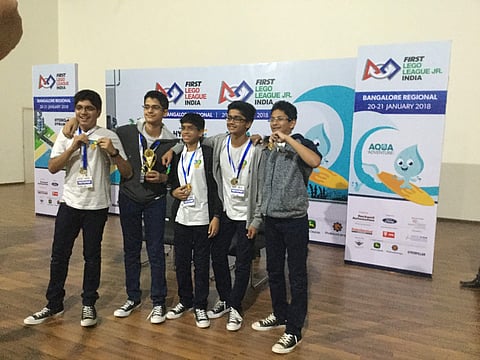

While most of us studied about rainwater harvesting at school and gradually forgot it later on, these class X students from National Public School are propagating the idea of implementing community rainwater harvesting especially in apartments and gated communities. In 2017, five students — Param Nayar, Ashvin Raghavan, Akshara Joshipura, Rishank Kanaparti and Aditya Vemareddy — participated in the FIRST LEGO League, an international competition for elementary and middle school students. Explaining why they took up the concept of rainwater harvesting, Param says, "We were asked to find a problem in the water cycle and provide a solution for it. Through our research, we found that with the increase in the digging of borewells, the groundwater level had decreased to a large extent. Whenever people build apartments, they dig borewells and, over time, the resource gets exhausted. Therefore, we suggested that community rainwater harvesting could be the solution to this problem in urban areas." Two years later, Param and Ashvin continue to research and work on their project with the assistance of three other friends. The duo has also joined FORCE, a not-for-profit organisation that works to solve the water scarcity problem across India.
How can rainwater harvesting benefit us?
There are several benefits one can derive from rainwater harvesting and that is exactly what Param and Ashvin have been trying to convey to people. Since rainwater is the purest form of water, one can use it for domestic purposes, thus reducing dependency on municipality water. But this largely depends on the individual's level of awareness and efforts. By saving rainwater, the groundwater gets recharged and there is a significant increase in the groundwater table over a period of few years.
And their solution is?
To counter the depletion of groundwater, Param and Ashvin have proposed the idea of an intra-community roof rainwater grid which can happen only through community-level water sharing. "Our concept is similar to the Tesla Powerwall where a user can save sunlight in the form of electricity to reduce the dependency on electricity supply. One should have the required infrastructure in their apartment or even office premises to implement this idea. The concept is very simple. Every house will have a pipe connected to multiple underground community water tanks. When it rains, the water from the roof every house gets collected in this pipe. We have fixed a sensor pipe which tests if the water is fit for consumption. If it is not fit for consumption, then it will be passed for groundwater recharge and if the water is of good quality, then it goes through several filtration processes. Finally, it gets collected in the overhead water tank which can be used for multiple purposes, thus reducing the dependency on other sources and saving money as well."
Storage options and the cost
Since the project involves the storage of water in tanks, they have provided different options that are cost-effective. Param explains, "There are closed water tanks and open water tanks as well. And one can either invest in a Ferro Cement tank which will cost `8 to 10 per litre or plastic tanks which will be cheaper, somewhere between `5 to 6 per litre. The same options are available for open tanks but to avoid any kind of danger, they can be covered with plastic sheets."
Drowning in benefits
The best part about this solution is that it can be done in both individual houses and apartments, and once the total infrastructure is ready, one can derive a large amount of water from these tanks. "With the individual storage solution, a 10,000-litre tank can store around 90,671 litres for 168 days. In the case of the community storage solution, then each house will have enough rainwater for 181 days. If the occupancy of the community and the roof catchment is more, then the houses can get sufficient water for almost 226 days," adds Param.
Recently, the duo, through FORCE, presented their idea to Philips-India and they liked the idea. Aside from this, they have also approached several individuals and apartments to create awareness on their method of rainwater harvesting. They even attended the World Water Summit and their presentation was awarded the Best Presentation award. They hope to participate in several more competitions and present their idea to more people.
